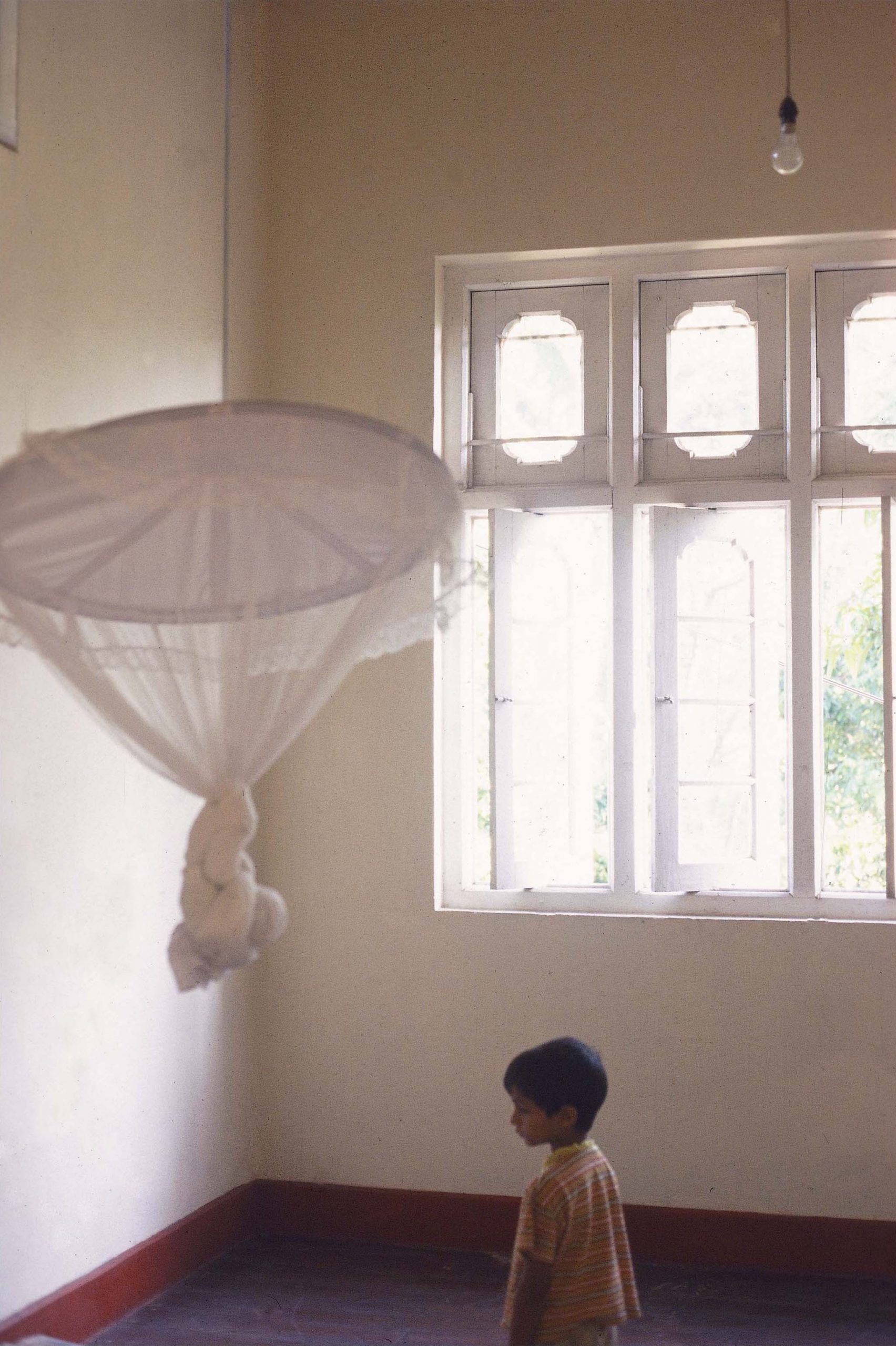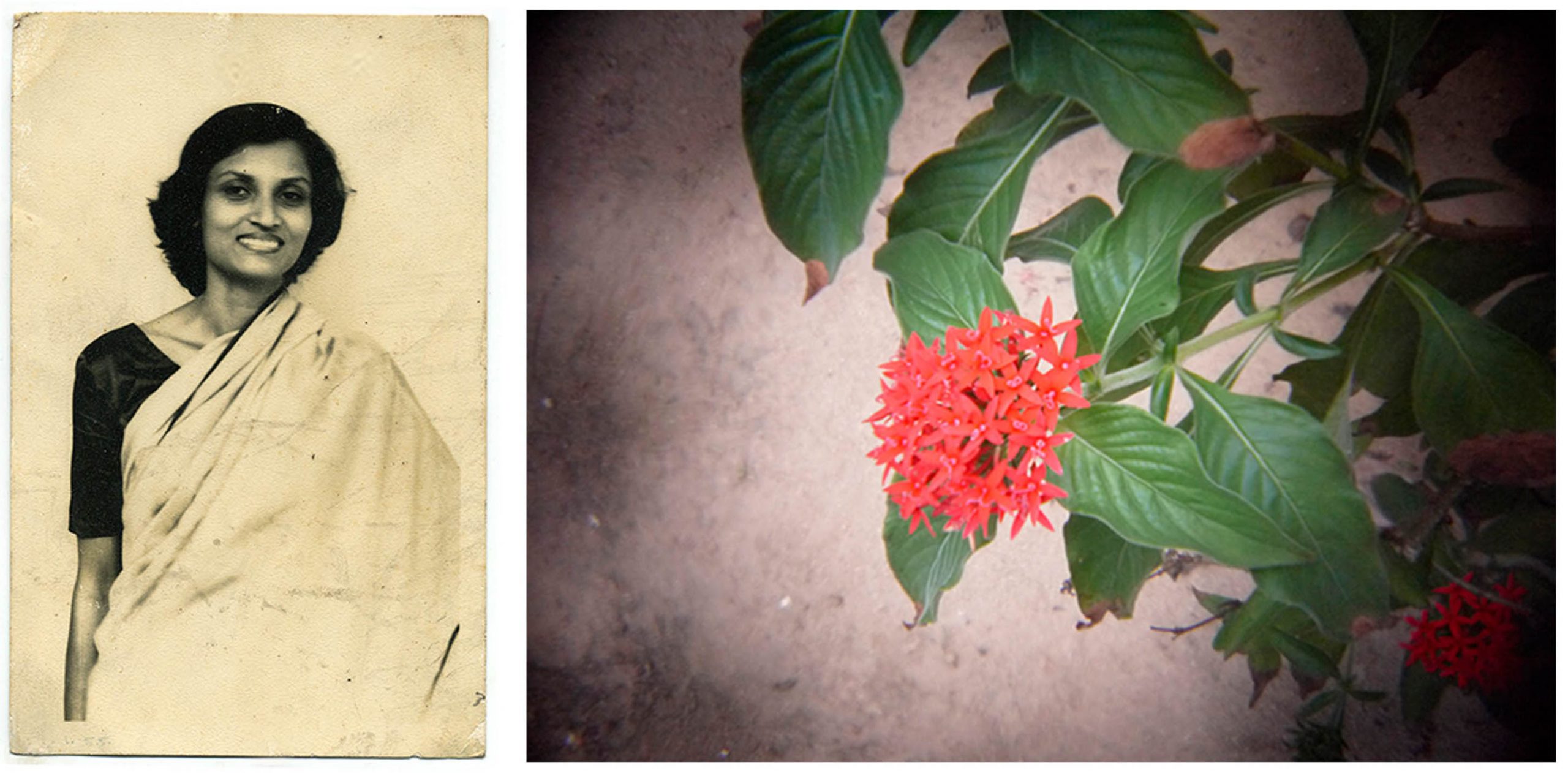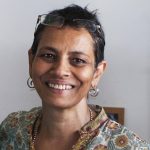Menika van der Poorten in conversation with Jyoti Dhar
When I was with my father’s family, the ‘Eurasians’, I felt very much part of that world. When I was in my mother’s Sinhala world, I felt part of that, so I felt a bit like a yo-yo. I wanted to know more about the Eurasians… I started digging around, collecting stories. There was an urgency because that generation of people who considered themselves Eurasians were all dying or losing their memories. Their stories and lives always fascinated me.
—Menika van der Poorten
Jyoti Dhar (JD): I’d like to ask you about some of the moments that led to your interest in mapping social histories, such as your early exposure to left-wing politics in London.
Menika van der Poorten (MP): I had a normal middle-to upper-class kind of life in Sri Lanka, but we were different. My father was Eurasian of English, Belgian and Sinhala descent and my mother Sinhala. My mother, stepfather and my father (in England) were all left-wing Trotskyists. In that sense, a lot of my ideas and viewpoints were influenced by those belief systems. I remember that at the age of ten or eleven, my heroine – the person I looked up to – was Angela Davis; and Ho Chi Minh at the time of the Vietnam War. I don’t think many children had that kind of household exposure to anti-imperialism.
When I was seventeen or eighteen, I went to live with my father in England, at my insistence. But the reality of life with him and my stepmother and their three children was very, very different from what I was used to or expected. They were a rather odd and somewhat dysfunctional household. We lived in Clapham, which in those days was the heart of working-class South London. My dad was a radical left activist but I went to a really fancy non-fee-paying girls’ school in Hammersmith, so I led a double life. He wasn’t really around very much, and I remember that he never had any money. So I thought: Okay, I have to find a job.
First, I worked for the party he was a member of, the Workers Revolutionary Party, and then somewhere along the way, I left my dad’s and I went to live with some friends of my parents who were English and also old communists. So that was another alternative kind of left-wing household, their children and friends were artists and musicians and so on. From there I went to Newcastle University, but I wasn’t really convinced in terms of what I was studying. I left Newcastle, returned to London and later married my boyfriend Richard, who was a member of the Communist Party too. It was Richard who taught me photography.

In my twenties I joined the Labour Party and became quite involved with its women’s caucus. This was my first encounter with feminist politics. I was living in Kilburn at the time. I came across the Brent Women’s Centre, where I met radical Black women who exposed me to different ways of looking at politics, at racism, at equal opportunities, at the representation of Black and Asian women, and so on. Even if you didn’t always identify racism as racism, or even have a name for those forms of discrimination, you always recognized it, knew it when you came across it. In those days, ‘Black’ included Asians, and African Caribbean people, so it was a more inclusive term in the political sense of ‘Black’.
Other significant events like the Third World book fair and the Feminist book fair were taking place at the time in London. There were publishers from everywhere, including the Kitchen Table Women of Colour Press from the US, lots of feminists not normally heard of, and famous author-activists as well. I remember seeing and meeting Fatima Mernissi, Nawal El Saadawi, and a lot of radical women of colour from the US, including Audre Lorde and June Jordan. We were all – I don’t know – inspired! All these impressive women were in London, and there was such a buzz.
JD: Is this when you joined Sheba Feminist Press?
MP: I had left my marriage and around that time I was invited to join Sheba Feminist Publishers, a small independent collective. It was an extraordinary time. A time of dynamic political and cultural activism, of hope, of change. I met all these women who were active politically, artistically and culturally. Some of them are now fairly well known – and about time too! – Jackie Kay, Claudette Johnson, Sonia Boyce, Bernadine Evaristo, Chila Burman, Ingrid Pollard and Maud Sulter.[1] I didn’t know Lubaina Himid, but I remember her curation of the exhibition The Thin Black Line at the Institute of Contemporary Arts in London in 1985. This was one of the first exhibitions of work by Black women artists, and everyone was talking about it. I went to see it – the display was along a corridor, and I remember thinking: Why is this exhibition in a passageway? Why is it not in a room? So, people of colour were recognized in a sense but also kind of constantly marginalized.
JD: How did these ideas about the politics of representation and the role of identity manifest in your own practice at the time? Did they influence your decision to study photography?
MP: My appetite for photography was really whetted when I joined Format Women’s Photography Agency in London. I was getting more interested in critical photography because I was either commissioning work or being a photo editor, so I had to constantly look at images and think about how we imaged women. Format was very much about empowering women in the sense of giving agency and voice to women photographers. So I think of that as being an intellectually crucial time for me. The Format agency photographer Maggie Murray had written a small, radical book about photography and representation; the scholar Paul Gilroy was writing about the Atlantic slave trade, and producing work such as There Ain’t No Black in the Union Jack: The Cultural Politics of Race and Nation, published in 1987. These critiques were quite influential. And then, working with Monocrone Women’s Photography Collective in London was a turning point for me. We taught photography to women, we organized exhibitions, and we organized Women Focusing, a photography festival which was very much about being inclusive and trying to get more Black women involved in the existent photography spaces.
JD: So you’re part of these movements in the late 1980s and ’90s that allowed for a kind of optimism. But at the end of the ’90s you think about going back to Sri Lanka?
MP: It was mainly because I became a mother. I wanted my children to have an experience of belonging in Sri Lanka.
JD: So you take this decision to leave England in 1999 and go to Sri Lanka and start thinking about what that meant for you now, as a mum, and living near your own mum and family again. And then you begin investigating this idea of your own Eurasian lineage. What did photography particularly allow for when you began looking into this idea? What was it like encountering the conflicting narratives and incomplete truths you have spoken about before when coming across family archives? And how did that feed into your work?
MP: Moving back for me was quite traumatic in many ways. Although I wanted my children to have an experience of belonging in Sri Lanka, for myself, I didn’t feel it was necessarily the best move. I was very conflicted. I felt very at home here, but part of me didn’t, it was this dual identity thing again. Although my mother was Sinhala and I went to Sinhala Buddhist School, I didn’t really feel Sinhala Buddhist. The school made me very conscious of being ‘mixed’. When I was with my father’s family, the ‘Eurasians’, I felt very much part of that world. When I was with my maternal grandmothers, in my mother’s world, I felt part of that, so I felt a bit like a yo-yo. I wanted to know more about the Eurasians who were from the ‘planter community’. They were very much about the land, but not of the land. There was no written history of Eurasians, I wondered what made them and my relatives, who they were. I started digging around, collecting stories. There was an urgency because that generation of people who considered themselves Eurasians were all dying or losing their memories. Their stories and lives always fascinated me. At times the stories felt like an overdone soap opera. They were of a time, of an era. Then the commission by Groundviews[2] enabled me to kick-start a deeper investigation into the community.
JD: What was the Groundviews commission and what came out of that commission? Was it your series Where Are You From? and The Real and the Imagined?
MP: The Real and Imagined was not part of the commission, but Where Are You From? was, and came first. I created the series of audiovisual narratives, shaped via interviewing, recording and photographing a number of my relatives and other Eurasians. Where Are You From – A Lost White Tribe (2010) was about the Eurasian community in general, and featured more of my grandmother’s family. The Real and the Imagined (2016) was a related body of work (exhibited at the Dhaka Art Summit 2016) developed specifically around my van der Poorten Belgian ancestry and family. These are ongoing series.
While immersed in the documentation process I realized that there were many incomplete truths and multiple versions of the truth as spoken by members of the family and community. This was fascinating. Some of my relatives took exception to accounts by other relatives, because they had a completely different version of how they perceived themselves and their family. But I had a lot of appreciative emails, especially from Eurasians overseas, to say how glad they were to see the Eurasian community represented in some way.

JD: On the one hand it’s deeply personal, about these two sides to your family, Sinhalese-Belgian, but also it’s about much wider kinds of political narratives, these social histories you’ve always been interested in. I wonder if it connects to these different bodies of work you’ve done on fragmented, suppressed or overlooked histories in Jaffna, Belfast and Scotland?

MP: Yes. They are interconnected in a way.
I went to Jaffna soon after the civil war ended.[3] It was really eye-opening. I felt side-swiped – it is difficult to describe all the emotions. In a weird way, everything seemed frozen in time, the little lanes and bicycles reminded me of my childhood… and then, in contrast, the decimation, the abandoned, ruined buildings, were just indescribable. It all hit me in a very visceral way. You knew of the horror, but actually being there – seeing the empty houses and thinking, where are these people now? – made me feel inarticulate, locked in a tangle of emotions I couldn’t even identify. I did photograph Jaffna, but I wasn’t quite sure how to effectively do it, and all the while I was asking myself whether it was even my place to represent or present it. I kept recalling this poem I had read: ‘A Package Tour to a War-torn Territory’… I felt it wasn’t my story to tell, but at the same time I felt it needed to be sent out and shared with the world. Taking photographs felt intrusive and at the same time not. So I didn’t actually do anything with the images. They are still waiting to see the light of day.

Photo-documenting in Belfast was also quite significant for me – there were incredibly contradictory things going on there too, and many parallels between the Sri Lankan civil conflict and the ‘troubles’ in Northern Ireland. Again, I haven’t exhibited that body of work.
The images of Scotland are slightly different. This is a hidden history which is in ‘gestation’ still. I was living in a beautiful semi-isolated landscape in Scotland for a month. I soon realized I was in fact located in the middle of UK’s Trident nuclear weapons programme and I was but a stone’s throw away from the missile silos where the nuclear warheads were stored. Also not far away was Faslane, the submarine base at the heart of this programme employing over 8000 people. There are many strands to this, and it is on a back burner too at the moment.
JD: Coming back to Sri Lanka, I want to talk about two other important series that stemmed from motherhood: that lovely series you did of your own boys, but then with the passing of your own mother, which was another profound moment in your life, some of the work that came out of that. I wonder if you want to speak a little bit about that work because I found it really beautiful and joyous and sad and there was so much in it at the same time.

MP: I photographed my mother through the years, on and off. But of course, you know how it is – when one’s parents are around and very much alive, one doesn’t record them or spend as much time with them as one should…
For me, my mother was a rock. She was an exceptional figure, a pioneer. She came from a very feudal sort of background; she and her sister were the first women from our family to go to university. Amma, a political rebel, then joined the Trotskyist party. She ran for office in a general election, taking me, aged all of two, on the campaign trail with her. She was also a scientist; she worked as general manager of a government institution; later she became a leading environmentalist. She didn’t see boundaries. The words no and can’t didn’t exist in her vocabulary. It was hard to live up to as a daughter.
Amma died of cancer; from her diagnosis to her passing, it was only seven weeks. When Galle-based artist Mariah Lookman asked me to participate in her curated exhibition Tonight No Poetry Will Serve (2021),[4] a fundraiser for the arts-focused initiative Cancerfund-Galle, I decided to show works featuring my mother. Those images were symbolic, and of her love of nature, love of the land – things that were important to her.

JD: What are you working on now, and what is your next project?
MP: I want to archive my analogue images. I also want to develop more land-related works. I have some images in Shining Lights: Black Women in Photography in the 1980s-90s, a recent ongoing digital archival project leading to a book, to be co-published by Autograph and MACK. This reaching back into photographic meta-history made me aware of the need to reflect on and digitize my own archive.
Notes
1. Jackie Kay was the Makar (poet laureate) of Scotland from 2016-2021. Claudette Johnson is “one of the most accomplished figurative artists working in Britain today” (Modern Art Oxford). Sonia Boyce was joint winner of the Golden Lion at the 2022 Venice Biennale. Bernadine Evaristo was joint winner of the 2019 Man Booker Prize. Radical Pop artist Chila Singh Burman was commissioned by Tate Britain in 2020 to transform the gallery portico with an installation of lights (that included overlaying the statue of Britannia with an image of goddess Kali). Artist Ingrid Pollard was nominated for the 2022 Turner Prize in the UK. Maud Sulter (d. 2008) was a critically acclaimed writer and internationally exhibited visual artist. Awarded the Turner Prize in 2017, Lubaina Himid was the first Black woman artist to win this honour.
2. Groundviews.org is a citizen journalism website in Sri Lanka. In 2011 the site commissioned a number of visual artists to produce audiovisual narratives, which were then exhibited online and are still available to view. For Menika van der Poorten’s work on the Eurasian community, see https://groundviews.org/2011/04/12/a-lost-white-tribe-the-eurasians-in-sri-lanka/
3. The civil war between Sri Lankan government forces and the guerrilla army Liberation Tigers of Tamil Eelam (LTTE) demanding a separate homeland for Tamils in the north of the country lasted from 1983 to 2009, with Indian military intervention on the island between 1987 and 1990 (leading to the assassination of Indian Prime Minister Rajiv Gandhi in Tamil Nadu by an LTTE suicide bomber squad in May 1990). According to UN estimates, there were between 80,000 and 100,000 casualties, and systematic perpetration of war crimes against civilians of all ethnicities – rape, torture, abductions, massacres, bombardments and assassinations, as well as LTTE suicide bombings and use of child soldiers. The full impact of war-related human rights abuses has yet to be accurately investigated and documented by independent international assessors.
4. Title of a poem by renowned American feminist-activist poet Adrienne Rich (1929-2012).
Menika van der Poorten is a cultural producer, photographer and photography educator based in Sri Lanka. She has exhibited widely, both locally and internationally. Her work will be featured in Shining Lights: Black Women in Photography in the 1980s-90s (Autograph and MACK, forthcoming).
 Jyoti Dhar is an art critic and editor based in Dubai. Her writing has focused on contemporary art from South Asia. She currently manages editorial and content strategy for Sharjah Art Foundation.
Jyoti Dhar is an art critic and editor based in Dubai. Her writing has focused on contemporary art from South Asia. She currently manages editorial and content strategy for Sharjah Art Foundation.
